Episode #312: How To Choose A Core Math Curriculum Resource For Your School / District’s Math Program
LISTEN NOW HERE…
OR JUMP TO YOUR FAVOURITE PLATFORM
WATCH NOW…
Episode Summary:
Struggling to select the perfect math curriculum for your school?
Selecting a core resource or curriculum for your math program is no small task. It can feel overwhelming and high-stakes, especially when considering the long-term impact on students and teachers alike. In this episode, Jon Orr and Yvette Lehman break down the essential steps and considerations to help you navigate this critical decision-making process with confidence.
You’ll learn:
- Why having a clear vision is essential for choosing the right curriculum that aligns with your goals.
- How to balance the need for a flexible resource that teachers will love with the goal of meaningful instructional impact.
- The importance of building a solid foundation that allows teachers to innovate and engage students effectively.
Ready to make curriculum decisions that will truly transform math learning? Listen now to gain actionable insights and start building a stronger math program today!
Resources:
- Not sure what matters most when designing math improvement plans? Take this assessment and get a free customized report: https://growyourmathprogram.com
- Ready to design your math improvement plan with guidance, support and using structure? Learn how to follow our 4 stage process. http://makemathmoments.com/discovery/
- Looking to supplement your curriculum with problem based lessons and units? Make Math Moments Problem Based Lessons & Units
Be Our Next Podcast Guest!
Join as an Interview Guest or on a Mentoring Moment Call
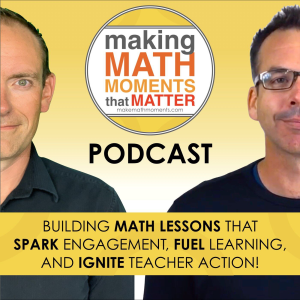
Apply to be a Featured Interview Guest
Book a Mentoring Moment Coaching Call
Are You an Official Math Moment Maker?

FULL TRANSCRIPT
Jon Orr: In this episode, we’re going to help you answer the question How do you select a core resource or a new curriculum for your math program? And I’m John OURAND. I have Yvette Leeman here from Math Moments. And we I make math moments are always trying to help you cultivate foster your mathematics program like strong healthy and balanced tree.
And specifically in this episode, we’re going help you create, coordinate math improvement plans so that you can create long term, sustainable student success and mathematically proficient and pedagogically strong teachers. Yvette, let’s jump in. Let’s talk about core resources, curriculum selection. I know you have some thoughts on that, but let’s help everybody think about how do we select that curriculum, that that resource that teachers have at their fingertips when they’re there teaching their math lessons? What are your thoughts so far on on what is important when we’re going to select that resource that we’re going to put in the hands of our teachers from K to 12?
Yvette Lehman: For anybody who’s engaged in this process before, you know that this is a lofty task and it’s also one that comes with a significant amount of pressure. There’s usually like big dollar signs next to these purchases, and you often are purchasing a resource that’s going to be in play for a significant amount of time. You know, sometimes we buy a textbook that might remain in classrooms for ten, 15, 20 years.
And so when we go about this process and we have the opportunity to select something new for educators, we want to make sure we do it right, sure that it has the lasting impact that we’re really hoping for. So, you know, for anybody who is engaged in this process before, of course, you know, gathering teacher input, teacher voice is critical to the process.
Jon Orr: Right.
Yvette Lehman: The last thing you want is a resource that nobody wants to use.
Jon Orr: True. True. Yeah. Like putting. How many times have you probably been in the classroom when you were you were teaching and are like, here you’re looking at something and you’re trying to make that choice. Well, I use this. Why should I use this one? You know, and then someone’s like, Here, you should use this one. And you’re like, But I that’s not like fitting, like what I wanted to do.
And then you’re all you’re already teachers are going to be searching elsewhere. So like you’re saying, teacher input is important. I’m going to argue first and foremost that we have to have at our level, say at our program level, ah, coordinator level, ah, superintendent level up, principal level. Whoever is in charge of making these decisions like you’re selecting this curriculum, I would say that we need we need that vision in place.
We need to be like, what is it that our math program here is, is is able to do? We have to have that that clear vision. I think just just to start this conversation, to start that that selection process. Because when you have your vision and be like, look, five years, ten years from now, this is where I think math education is going to be.
Wouldn’t it be easier to select our curriculum, our resource, because some curriculums are going to be like that will help us get there and this curriculum might not help us get there. So we need to like have that in place and then also have in place that next layer down. Like what are where are kind of like our holes right now?
Like where do we need to make changes in the work that we’re doing? Like what objectives? What priorities, what focus zones do we really want to strengthen with our teachers and strength and therefore strengthen those those practices that are happening in our classrooms better. Therefore, you know, giving our students the experience that they want, like we have to be clear on like where that change has to happen.
If we’re selecting that new curriculum and that new resource so that we can we can go again. They become the filter, right? They become like, hey, I have to select a new curriculum. I’m not just going like, is this the right one? I don’t know. Like, what do you think? Maybe I’ll go to a session on it and let the publisher tell me why it’s important.
Like we have to have that clear filter. Like, these are the top three things I’m working on or we’re working on to strengthen in our school system to get closer to our vision. Does this curriculum, does this resource help us get there easier or is it going to be like a little bit more pulling teeth? Because if it if I choose this one, then am I plugging holes along the way? Do I have to fill in gaps like afterwards? Like we have to have that clarity while we go into the selection process.
Yvette Lehman: So it’s really finding that balance between selecting a resource that’s going to be implementable for teachers, that’s going to appeal to them, that’s going to lift their burden and make them want to shift towards that resource. But also selecting a resource that’s going to move you closer to the goal of change you want to see in the system.
Like how does it advance teacher practice, how does it improve student outcome, and how does it also, you know, position educators to be culturally responsive and affirm identities and differentiate? Does it have sound assessment like these are all the things that we want to think about when we are selecting a resource? But to your point, John, it’s like we need to have that clarity before the process even begins.
That we can clearly articulate to educators who are piloting the resource we need to almost establish a common understanding of the characteristics of the resource that we’re going to select before we engage in the process. And that’s not to place any bias on the process, but it’s just to really have a a common understanding of what we think is going to help us move students towards greater success or help position us to be more impactful in the classroom.
And we want the resource that we select to do that. We don’t want it to necessarily remain status quo with our practice. We want it to help us innovate it. We want it to reflect recent research and best practices. So I think, like you’re saying, it’s like that real clear vision to start helps us navigate this process where everybody’s on the same page and I’m able to gather teacher feedback in a way that not only honors their, you know, the use of the tool and whether or not it’s accessible to them, they can use it in a reasonable amount of time.
The layout is friendly, but also, does it help me reach more students? Does it position me to be more responsive, more effective and, you know, really solidify student understanding in the classroom?
Jon Orr: Right. Are there some like some non-negotiables that you would have on your radar here, like you’ve mentioned, like things to consider for criteria in selecting? And I think we I think what we’re arguing here is to get clear on on what it is that you would like to have and then does this resource help you get there. But think about the opposite.
Like think about some resources you may have analyzed, looked at and said, these are things that we’re not choosing. Or maybe you selected one. We’re like, I wish I had chosen something different. And and now I’m stuck with this for the next few years because of the price tag. And in the contract that we would be signed, anything, anything to kind of warn people about at this point.
Yvette Lehman: You know, what I always say is like, I want a resource that presents really rich tasks, right? Because that’s the heavy lifting. Like I can build practice worksheets.
Right. Like the practice to me is not necessarily the really cognitively demanding thinking when it comes to planning, but like I really want a resource that’s going to include tasks that promote resource and problem solving. I want a resource that’s going to leverage models and leverage context and really explicitly introduce strategies. And I mean, I don’t know in your experience, John, if you’ve ever found like the perfect resource, you know, I don’t know that it exists, like one resource that does absolutely everything you want in a math program completely comprehensively, I’m not sure, but I just would want something really solid as the base.
I’d want it to, you know, really reflect the standards or the expected issues with fidelity so that I could trust. But if my teachers were using this resource and nothing else that, you know, it’s a solid base, right?
Jon Orr: Yeah. No, we often ask this question. This is why we wanted to have this discussion here on the podcast, because we get asked this question a lot about like what resource should we be picking? You know, we, we partner with school districts all across North America on on creating their improvement plans and supporting those. And again, this this question comes up and we find that some you know, we’ve had this scenario where where one district is considering adopting a new curriculum or a new resource and they’re picking, you know, they say the name of that particular resource and they’re switching from another one.
And, you know, they’re trying to decide whether this is the right one to move towards. And then we have another you know, we’ve hopped on a call right after that, working with another district across the country, and they’re doing the exact opposite switch. And it’s really because they’re they think that the curriculum is the thing that’s actually going to be the change.
And in reality, what we help them decide is like, what is it that you want that curriculum to help you do? Because because what oftentimes when we think about math education of math improvement, we just continually think about the resource and not the actual outcomes we want our students to engage in. And it’s like it’s like thinking about, hey, what do we have?
We’ve got that, we’ve got that, we’ve got that. And then all of a sudden it’s like But then but in service of what? Right? Like we’re not clear on like what is it that we’re trying to do? And therefore when you have that clarity and you have the, the understanding of like this is where we’re trying to go, then you’re right.
Like choosing that curriculum in a way, as long as, like what you’re saying you about as long as it’s like a good base for the things you want to be strong at in terms of your, your objectives in your, in your kind of focus zones, like, like thinking and allowing, allowing for easier access of lesson lessons to engage in, you know, using particular models, particular strategies to build fluency for students to, you know, allow, allow, you know, productive struggle to happen.
And the lessons are maybe allow, you know, lend themselves that way. You’re right. Like we can. We can always supplement practice and but no, there is no there is no perfect curriculum. It it is it is trying to select that that sound for for educators to have access to. Now this I think this brings up another another kind of question that we get asked as well is is like, should I just not have like a core resource?
Like, what about like and this this idea comes from a fundamental thinking that that makes sense to me is, is that we want just like we when we want students to be thinkers and actively thinking in our classrooms, we want our teachers that we’re supporting on a regular basis to also be great thinkers about, you know, their math education that they’re providing their students.
We want them to to not just be robots who are turning pages from a textbook. They go, well, what is next week look like? Or What’s tomorrow look like? I don’t know. I’ll find out tomorrow when I turn the page. Like we worry about that. I think in our roles and in we sometimes swing from one side of the pendulum to the other by saying, you know what, let’s let’s actually force them not to turn the page.
And what we’ll do is we won’t we won’t, you know, replenish or buy the next textbook or the next curriculum resource. And we’ll and we’ll help them kind of navigate how to build, you know, their math programs. But what you find, right is that when you throw the textbook out is that you now have nothing to rely on like you have. It’s almost like, what do we do? Like, are we building everything from scratch? Like, there is a lot of concern, right there.
Yvette Lehman: Well, and if you had had asked me this question ten years ago, I would have been in the pro no textbook camp like that was the shift I made in my own classroom. But I was also ready for that shift. I’d been teaching the same grade multiple years. I was really supported by a teaching partner I had built in positive.
I was just I was ready to make that shift and be more innovative and creative and and really design my math resources and be able to pick from different things that I felt were right at the right time. But that’s really not taking into account all of the educators in the system and thinking about the elementary context, where you teach and have to plan for multiple grades.
We’re assuming that all teachers are positioned to deeply understand their curriculum, that they’ve taught that curriculum before, that they understand the connections, they know what the mean. You know, the big ideas are that they’re trying to elicit. They can scaffold and sequence one unit from the next to tell this really interesting mathematical story and journey. And I mean, as much as I’d like to believe that that’s where we are, I don’t know that that is a realistic expectation on the demands of of an educator who doesn’t only teach math.
Yeah. Like when you think about I have to plan that way. I have to every single unit build out my unit and pick from a variety of different tools at my fingertips. That means I need to understand all of those tools. I need to understand how they work and when they work and what they do for me. And more importantly, I have to really deeply understand the curriculum.
So when I think about new teachers, teachers who are new to A-grade, teachers who have, you know, even just significant demands at home because they have young children and they’re trying to balance a work life balance. I just don’t know anymore. And I think I’ve like you said, like the pendulum. I’ve really swung into the other camp where we have to provide something as a base.
And the comment I think I made to you the other day, John, is that if we can provide the base, you know, just just the kind of core resource that I get to use day to day to build up my program, that actually frees up cognitive and creative space for those teachers to then inadvertently and learn a little bit more or supplement or add because they can trust that the core is there.
And now it’s like, okay, well, I can trust that that’s there. I know it’s available to me, but I’m going to bring in these number strings because I know that they’re going to be really impactful or I want to bring in more explicit instruction around strategies. I’m going to bring in more interesting and targeted centers for my students. If we want teachers to be in that creative and innovative space, we have to lift some of the burden that comes with planning multiple subjects in multiple curriculums.
Jon Orr: It totally makes sense. And I and I think we you’re right. Like when you think back to, you know, if you’re listening right now and you were in that space where you felt comfortable, you were confident you could adapt on the fly, you know, and create you know, you created these robust teaching environments for your students. It’s likely that you you were either, you know, very experienced in that particular subject.
You had a lot of professional development learning throughout throughout your years. You probably just knew your standards. You knew your curriculum inside and out just from experience and and comfort. And then you could adapt. You could you could be flexible. You could know where the you know, where you needed to bring your students most. You know, a lot of people aren’t there like like you said, like they’re teaching many subjects, but also they they don’t have say that comfort yet it’s like we’re trying to create that I think that’s what we’re trying to create in our roles is we want to create a flexible, robust educator who who is making these moves in their classrooms.
And and this is part of our, you know, making strong improvement plans is how do I how do I build this? And part of it is, is giving and structuring for that base of curriculum, because imagine that if you wanted to fast track your teachers to get to that spot is don’t take that curriculum away like don’t unless it’s just a set of worksheets, right?
Like it might be the take it away, but what are we going to replace it with for sure. And let’s replace it with something that elevates the floor a little bit higher so that we are starting higher and then we can reach farther up. You know, it’s almost like you’re thinking about your tree in your in your in your classroom trees that you’re trying to build.
It’s like we’re we’re bringing the roots up. We’re bringing we’re bringing this, like, ground level up a little bit higher. Just start so that we can stretch and get those leaves and the branches higher up into the sky so our students can be, you know, it can be accessible for them and we can give them what we’re after.
And it’s it is curriculum resource is very important to to have kind of as as that base. So I think, Ivette, I think what we’re saying here is a few things, right? Like we’re saying, if we are selecting a curriculum, first of all off we’re saying make sure we select a core resource. Then we’re saying make sure you select that core resource that fits your values, your goals, objectives, your focus zones, because it’s going to make everything a little bit easier if you’re you’re starting there instead of starting from scratch or trying to, like, fit a square peg in a round hole.
It’s it’s be clear, though, and I think that’s right now where most of us, you know, when we first are starting to like choose resources for our classrooms because we don’t have that. We have not yet set a vision for mathematics for our organization or our school or our district. We don’t know what we’re working on specifically this year to improve, and then we don’t know how we’re measuring that improvement because the curriculum can be a way for you to help measure.
And and that could be, you know, the next steps forward. So we’re getting clear. We’re getting we’re getting focused. And then we use that focus to help be the filter for choosing that curriculum and make sure we choose that curriculum. Last any last big takeaways to leave with the audience here?
Yvette Lehman: Yeah, I think I just want to circle back to kind of my first reflection, which is that this is a big job and it’s an important one. So before you’re ready to engage in this process, I think it’s worth taking the time to get together with your leadership team and to, as John said, like really establish what the outcome you’re hoping for being clear and bringing in your teachers who are piloting into the conversation.
You talk about this often, John, about that like intellectual ownership or ownership over the process. Like we really want to be including educator voice because again, we’ve all been in a space where we’ve we’ve maybe selected what we thought was, you know, the best resource out there. And then it was hard to implement because it just didn’t fit the realistic, you know, time or schedule of a teacher who is, again, juggling so many subjects.
So kind of in in summary, it’s like, yes, we want a resource in place. We want a resource that’s going to lift some of the burden of the day to day planning to create space for creative and innovative thinking. But we also want to be really intentional because this is a lasting decision that’s going to impact your organization, likely for many years before another large amount of money is put in place to replace it.
Jon Orr: Awesome. Awesome. All right, folks, we have two called actions here for you. One is, if you have not yet subscribed to our podcast, hit the subscribe button on the follow button. Make sure that you do that so that you get notified. When we put out episodes, we’re putting out two episodes every week on Mondays and Thursdays. Look for those episodes on Monday and Thursday.
The second call to action is if you’re not yet sure on exactly where your focus zones should be. This year we talked about focus zones and getting clear on what that vision should look like. Then head on over to growyourmathprogram.com. Growyourmathprogram.com. You can fill out our assessment there that’s gonna help kind of pinpoint which of the six effective teaching or effects, which of the six, we’re gonna scratch that. Which of the, I’ll start to get over for a minute here. head on over to growyourmathprogram.com. You’re going to fill out a quick assessment there, which is gonna help pinpoint which of the six components of an effective math program that you wanna kind of zero in on and focus on first or foremost for a good priority for this particular year. So growyourmathprogram.com, you’re gonna get a customized report from us that kind of helps you get started. All right, thanks everybody for listening.
Thanks For Listening
- Book a Math Mentoring Moment
- Apply to be a Featured Interview Guest
- Leave a note in the comment section below.
- Share this show on Twitter, or Facebook.
- Leave an honest review on iTunes. Your ratings and reviews really help and we read each one.
- Subscribe on iTunes, Google Play, and Spotify.
DOWNLOAD THE 3 ACT MATH TASK TIP SHEET SO THEY RUN WITHOUT A HITCH!
Download the 2-page printable 3 Act Math Tip Sheet to ensure that you have the best start to your journey using 3 Act math Tasks to spark curiosity and fuel sense making in your math classroom!
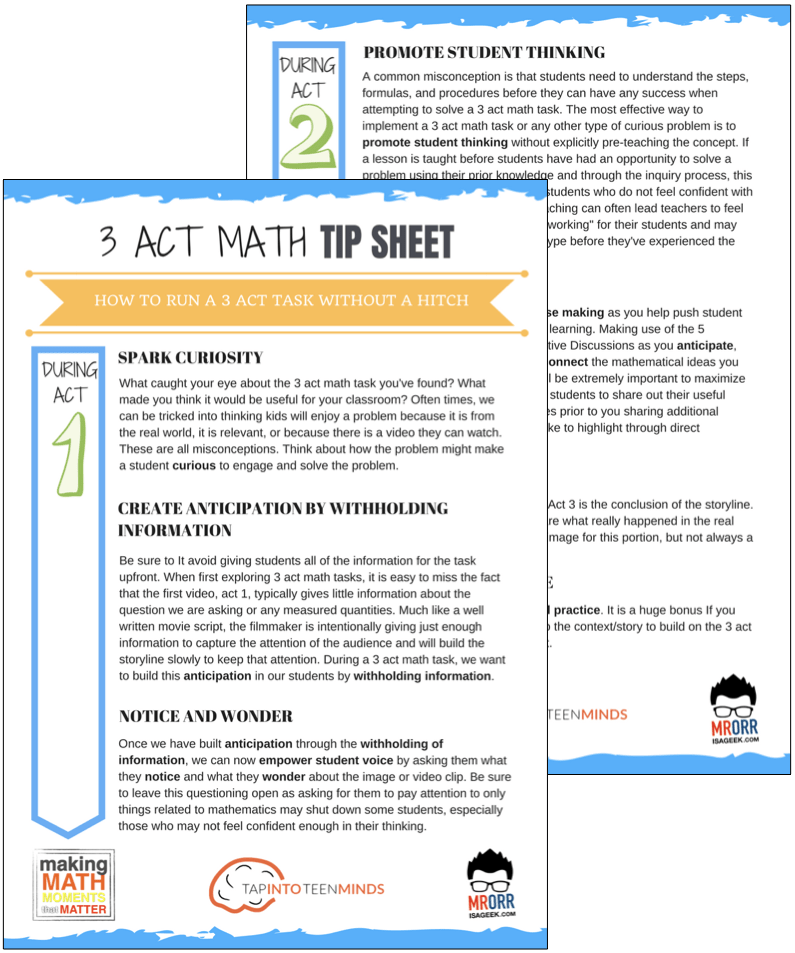
LESSONS TO MAKE MATH MOMENTS
Each lesson consists of:
Each Make Math Moments Problem Based Lesson consists of a Teacher Guide to lead you step-by-step through the planning process to ensure your lesson runs without a hitch!
Each Teacher Guide consists of:
- Intentionality of the lesson;
- A step-by-step walk through of each phase of the lesson;
- Visuals, animations, and videos unpacking big ideas, strategies, and models we intend to emerge during the lesson;
- Sample student approaches to assist in anticipating what your students might do;
- Resources and downloads including Keynote, Powerpoint, Media Files, and Teacher Guide printable PDF; and,
- Much more!
Each Make Math Moments Problem Based Lesson begins with a story, visual, video, or other method to Spark Curiosity through context.
Students will often Notice and Wonder before making an estimate to draw them in and invest in the problem.
After student voice has been heard and acknowledged, we will set students off on a Productive Struggle via a prompt related to the Spark context.
These prompts are given each lesson with the following conditions:
- No calculators are to be used; and,
- Students are to focus on how they can convince their math community that their solution is valid.
Students are left to engage in a productive struggle as the facilitator circulates to observe and engage in conversation as a means of assessing formatively.
The facilitator is instructed through the Teacher Guide on what specific strategies and models could be used to make connections and consolidate the learning from the lesson.
Often times, animations and walk through videos are provided in the Teacher Guide to assist with planning and delivering the consolidation.
A review image, video, or animation is provided as a conclusion to the task from the lesson.
While this might feel like a natural ending to the context students have been exploring, it is just the beginning as we look to leverage this context via extensions and additional lessons to dig deeper.
At the end of each lesson, consolidation prompts and/or extensions are crafted for students to purposefully practice and demonstrate their current understanding.
Facilitators are encouraged to collect these consolidation prompts as a means to engage in the assessment process and inform next moves for instruction.
In multi-day units of study, Math Talks are crafted to help build on the thinking from the previous day and build towards the next step in the developmental progression of the concept(s) we are exploring.
Each Math Talk is constructed as a string of related problems that build with intentionality to emerge specific big ideas, strategies, and mathematical models.
Make Math Moments Problem Based Lessons and Day 1 Teacher Guides are openly available for you to leverage and use with your students without becoming a Make Math Moments Academy Member.
Use our OPEN ACCESS multi-day problem based units!
Make Math Moments Problem Based Lessons and Day 1 Teacher Guides are openly available for you to leverage and use with your students without becoming a Make Math Moments Academy Member.
Partitive Division Resulting in a Fraction
Equivalence and Algebraic Substitution
Represent Categorical Data & Explore Mean
Downloadable resources including blackline masters, handouts, printable Tips Sheets, slide shows, and media files do require a Make Math Moments Academy Membership.
ONLINE WORKSHOP REGISTRATION

Pedagogically aligned for teachers of K through Grade 12 with content specific examples from Grades 3 through Grade 10.
In our self-paced, 12-week Online Workshop, you'll learn how to craft new and transform your current lessons to Spark Curiosity, Fuel Sense Making, and Ignite Your Teacher Moves to promote resilient problem solvers.

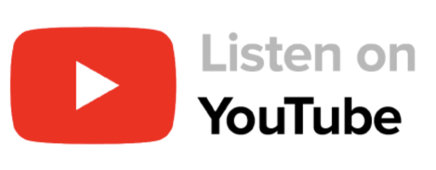


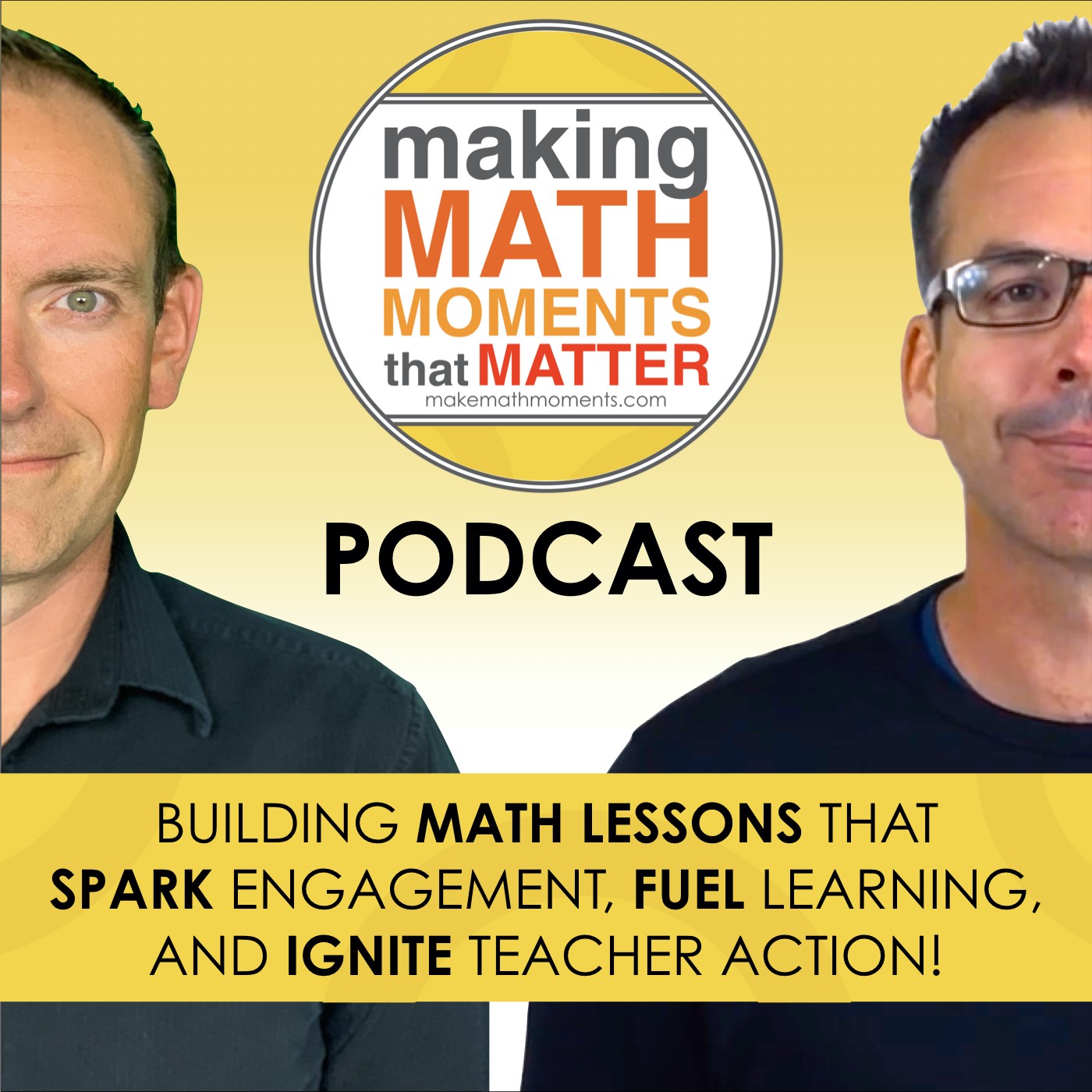
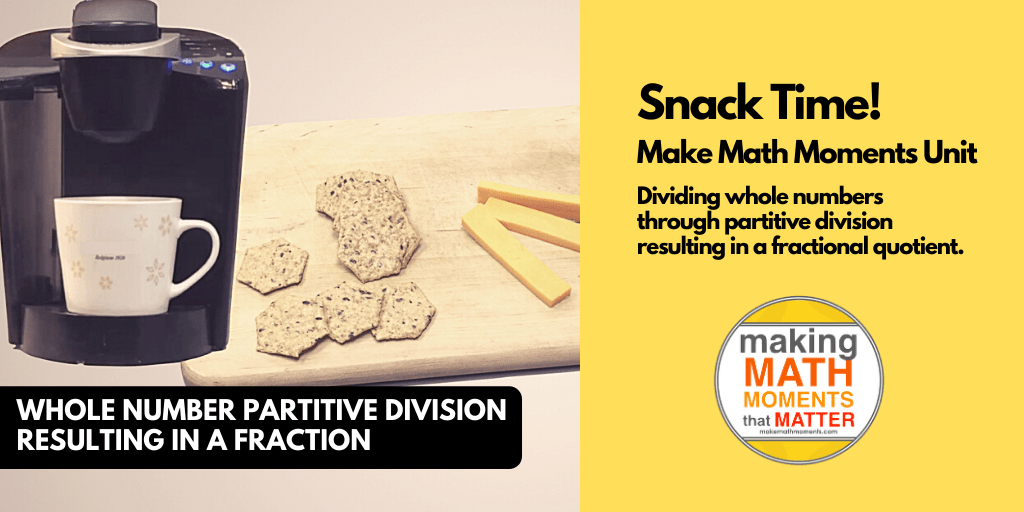




0 Comments